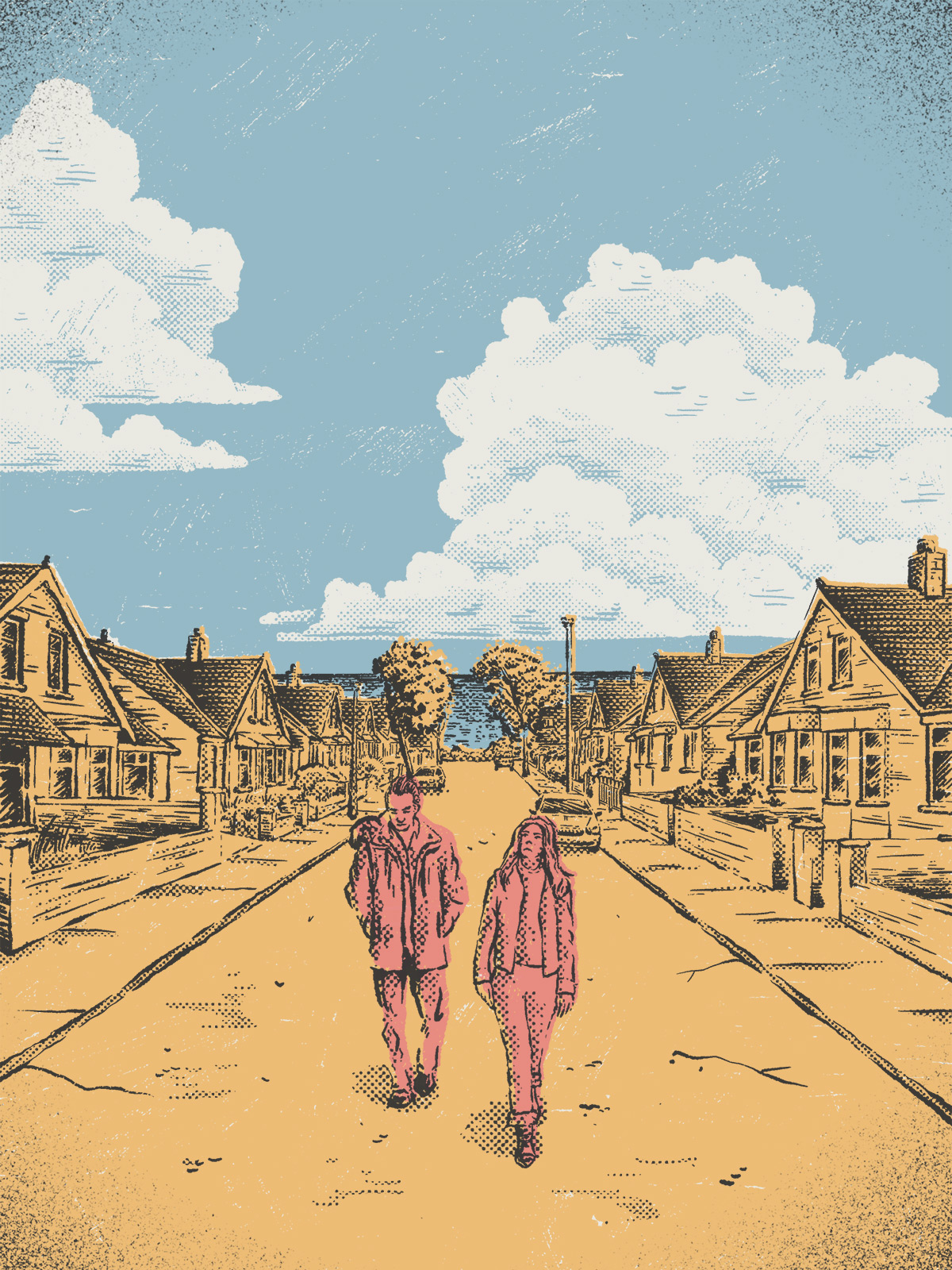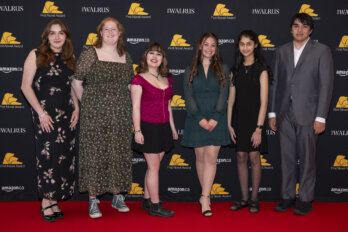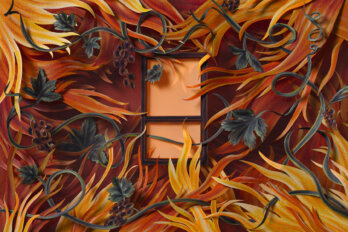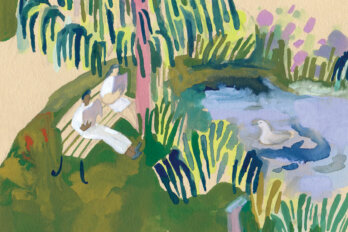How do I recognize a haunt? It’s a cultivated skill. The tipoff is that yearning expression in their eyes. That quality of stillness. Of detachment. An affinity for certain colours, musical notes, shapes in the rocks. Haunts are not truly in the here and now. It’s subtle, but once you’ve seen one, others are easier to spot. You just need to know how to look for them. And where.
I discover this particular haunt at the promontory bracketing the western reach of Cold Knap Beach. He’s facing the Bull Cliff rocks. The rocks are Liassic limestone—sedimentary layers bulging out of the cliff face. Nearly, though not exactly, like the bright-yellow stone in the cliffs of that other place. Click. When I see the way he gazes at the cliff, I suspect that he, too, has been there.
Only at low tide can you stand in front of Bull Cliff. The tide is turning, and in a few minutes, he will have to move. All I have to do is wait.
He puts his hands on the rock. You can’t wish yourself through—I know from experience. But he tries anyway and keeps trying until the sea surges above his knees and he has to let go. He slogs along the cliff, back to the pebbles of the beach. He’s wearing a large backpack that probably holds everything he owns. The waves crash against him, upsetting his balance, but he keeps his feet and makes it across the waterline. The pebbles at Cold Knap are pale grey. They rattle and jostle one another as the waves pull through them, and they roll underfoot as he walks toward me, leaving dark-grey prints in his wake.
I have found a place to perch on the pebbles with my sketchbook so I can watch him without appearing to. I don’t want to show my hand too soon. You have to be careful in these situations. If you approach someone thinking they are a haunt when they are only a tourist, it can be awkward. Like speaking Swahili to a Scot. Tourists don’t understand that you haven’t lost your mind so much as mislaid it. You know where you left it; you just don’t know how to get back there.
So you cautiously share a picture of a view and watch what happens. Some haunts don’t remember the other place distinctly, so you have to be oblique, to take them to the precipice and let them peer over the edge. Once they know, things in their life suddenly make sense. Why they chose a shabby apartment in a run-down neighbourhood when they could have afforded better. (Because it stood at the confluence of church bells, trains, and moving water.) Why they are mesmerized by the deep purple of a river in the shadow of a tall building. Why they were drawn here, to Cold Knap.
Others know what they remember. They write a story featuring a green door in a white wall, and you know that they have been there. You hear a certain phrase in the key of B-flat minor and know the composer has been there. Sometimes my work calls other haunts to me: I paint landscapes set along this stretch of coast. Déjà vistas, I call them.
I watch him with one eye as I work on my sketch of the Bull Cliff rocks. He looks as worn and frayed as his army-surplus backpack. The backs of his hands and his face are sunburned. He’s maybe thirty or forty-five. It’s hard to tell the age of a haunt. Sometimes we look younger than we are, sometimes much older, depending on how we’ve chosen to live with what we’ve seen. I keep sketching until I look down and see his boots, soaking wet, right in front of me.
Sometimes you have to be oblique.
“I sought a place I never found,” he says.
And sometimes there is no need.
“I hunted high; I ran aground,” I answer.
And so, we both know where we are—and where we want to be.
“Come for a walk,” I say.
I lead him along the promenade to my home, two blocks from the beach, on a road of whitewashed houses with little garden palm trees. I see him pause to look at the white-and-yellow awning over my front door. Click.
The haunt and I share a language of colour. Inside, he lifts a gold-lidded Mason jar from my mantel. It holds white seashells and purple sea glass I collected from the beach. Portable fragments of that other place, broken from the whole in my memory. He puts the jar down and gravitates toward the paintings in the conservatory, inspecting them one by one.
Oil paints and acrylics are too harsh for me. I use water-colours, more dreamlike and suggestive. I am lucky to be able to support myself selling prints, making a living through this weird kind of worship. It pays the bills and allows me to live where I want to be. Or near enough.
But a few of my paintings I never show to the public, only to other haunts. He’s staring at one now. Different people recall different vistas, but every haunt I’ve met has recognized this one. The sky is pale violet and the sea is amethyst. On the seawall, running along the shore, someone has written in chalk:
I sought a place I never found.
I hunted high; I ran aground.
I have impressions of other vistas in that place, ones that suggest even happier memories, but I cannot recall them fully. A vague sense of quiet well-being around the edges. I cannot relive them, and I certainly cannot paint them.
“How did you find it?” he asks.
“When I was five, I visited a distant cousin for Christmas. I became very ill. I awoke in a golden bedroom with stone walls, the sun-warmed smell of happiness. I wandered out to a narrow kitchen. A window with purple shutters overlooking a cobbled street, a view of homes built into the steep hill on the other side. It wasn’t winter anymore. The sunlight was bright blue and clean, its warmth not too heavy, not too hot. Perfectly comfortable. I could smell the sea—and something else.”
I have spent the decades since trying to identify that scent in bottled essences: violet, rose, lilac, lavender. None matched. In my mind, the smell is like the colour of rainbow moonstone.
“Lily of the valley,” he says, producing a tiny bottle from his pocket and handing it to me.
This is why I invite haunts into my life: sometimes they bring me pieces that fit into the empty spaces in my memory. I pull the stopper from the bottle and inhale . . .
. . . and I am in that other place again, in a mountain meadow carpeted with wildflowers. Music is playing faintly, a minor key, and there’s a house nearly tucked out of view, only the peak of its roof visible. Click.
The vision fades. I hand the bottle back to the haunt.
“Thank you,” I whisper. After he’s gone, I will try to paint the meadow.
The haunt looks at my other paintings, familiar views he’s never seen before. I give him one, painted on a Cold Knap pebble, to take with him.
He tells me how he found the other place. He was shown the way by a kindred spirit. She wore lily of the valley perfume and a gold bracelet studded with amethysts and opals. She took him there when he was eighteen. She died, and he has been trying to find it again ever since.
“How long have you been searching?” I ask.
“Twenty years.”
He tells me the story of his search, how he travelled aimlessly at first, crossing North America from east to west before going overseas. In Africa, he found violet-backed starlings: purple backs, white bellies, yellow eyes. “I thought I had found its heralds,” he says. “Surely, these birds had flown through it and bore its colours. I stayed there for a year, watching them breed, hatch, feed, and fly, until I came to accept that they were only the legacies of yesteryear. Maybe their ancestors flew through it. Their descendants carry its mark, but they are not its messengers.”
Next, he headed north, where lily of the valley grows, spent time in Asia and Europe, but had no luck.
“What happens when you’ve been everywhere on earth and still haven’t found it?” I ask.
“I will find it. There are always other places to look.”
“To search, but not to find.”
I tell him of a man who sought it along the byways of the mind: hypnosis, meditation, psychedelics. He claimed to have found it through the doorways of ketamine and lsd. He wouldn’t stop taking them.
“Do you believe he found it?” he asks.
“I don’t believe that drugs are the way there. Drugs are like sand, and it’s not the sand that makes the pearl; it’s the oyster.”
“But have you tried sand?”
“I don’t want to muddy the waters of my mind.”
“I thought I’d found it once,” he says, “in Spain, in a tourism office. I spotted a Polaroid. Drawings I’ve seen. Paintings, of course. But never a photograph. And suddenly there it was, stuck under the frame of a corkboard, surrounded by business cards and pamphlets for cheap accommodation. The same view of the seawall you painted. I asked the woman behind the desk and she told me she had taken it.”
“Where?”
“Along the coast. We got to talking, and I found out what she’d actually done. It was just a mock-up. She was trying to recreate it in the real world. She’d been raising money to buy some land on the coast, build a village, paint the houses, -cobble the streets, cut shapes in the rock, turn the sea purple.”
“And you didn’t stay to help her?”
“It wouldn’t be the real thing.”
“You believe it’s real?”
“Don’t you?”
“It’s as real as a dream,” I say. “Not real the way the Bull Cliff is real.”
“No, I suppose not. It’s better.”
I walk him to the train station, where he buys a ticket. As we wait on the platform, I look across the tracks to the profusion of brilliant greenery growing between the metal railings: deep purple in the shadows of the leaves; bright yellow, almost white, where the sun strikes. Click.
“I know why you came here,” he says, “but I don’t understand why you’ve stayed.”
“The climate, the sea, the rocks . . .”
“Come with me. Help me find it.”
“I have it here, almost.”
“You’re living on crumbs.”
It’s the last thing he says to me before stepping onto the train. As it pulls away, I see him through the window, looking into the distance ahead.
Years ago, I read about a psychological experiment conducted on young children. A hard candy was dropped into a plastic cup, which was then given to a child. Eventually, the child would associate the click of the candy hitting the bottom of the cup with the candy itself, and the sound would prompt the child to smile. This happened even if the child never received the candy. The click alone would make the child happy.
I believe that, if I ever get back to that place, it will be like the candy. And you can’t live on candy. But you can live in expectation.





